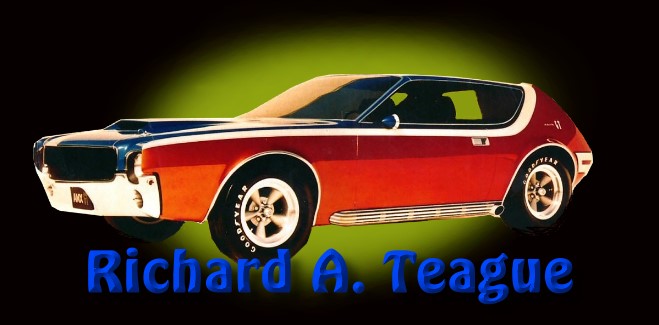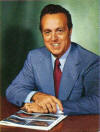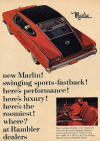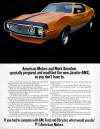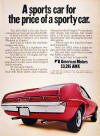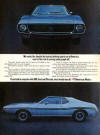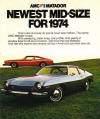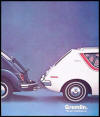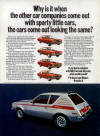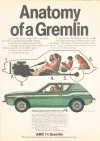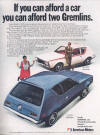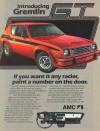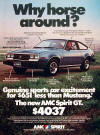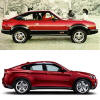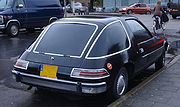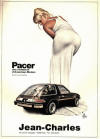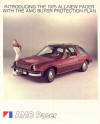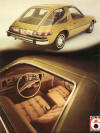AMC GREMLIN/SPIRIT/KAMMBACK
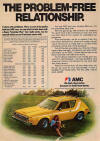
The AMC Gremlin is a
subcompact car that
was made by the
American Motors Corporation
(AMC) for nine model years. During its manufacturing run from April 1970
through 1978, a total of 671,475 Gremlins were built in the
United States and
Canada. The Gremlin was described at its introduction as the first
domestic-built
American subcompact
car. Responding to the introduction of competitors from Ford and
Chevrolet, AMC advertised the car in its second model year as "America's
first subcompact".The St. Louis-Post Dispatch states that to cite the Gremlin as
“America’s first subcompact” is to overlook the
Crosley and the
Nash Metropolitan.The latter—a subcompact-sized
"captive
import", American-conceived and
American-designed for the American market, and built in the
UK with a
British engine—has
a claim to be "America's first subcompact."[13]
AMC's designer
Richard A. Teague
may have come up with up the Gremlin's name. AMC apparently felt
confident enough to not worry about the word's negative connotations.
Time magazine noted two definitions for "gremlin":
Defined by Webster's as "a small gnome held to be responsible for
malfunction of equipment." American Motors' definition: "a pal to its
friends and an ogre to its enemies." The car was introduced on
April Fools' Day
1970, six months ahead of subcompacts from Ford and GM.[15]
It was created to compete with imported cars from Japan and Germany; and
although its appearance received some criticism, the Gremlin had an
important advantage with its low price. "With AMC's thriftiest six-cylinder engine and base prices below
US$2,000, AMC's
'import-fighter' initially sold well: over 26,000 in its abbreviated
first season" before the
Chevrolet Vega and
Ford Pinto were
introduced.[16]
Executives at American Motors knew that
Ford and
General Motors were
to launch subcompact cars for 1971, but did not have the financial
resources to respond with an entirely new competing design.[17][18]
Chief stylist
Richard A. Teague's
solution was to truncate the tail of a
Javelin (legend has
it that Teague sketched the design on a
Northwest Orient
air sickness bag).
The result was the
AMX-GT, first shown
at the
New York International Auto Show
in April 1968.[19]
The AMX-GT was never produced (although the "AMX"
name was used from 1968 to 1970 on a shortened, two-seat version of the
Javelin).
Instead, the new subcompact, designed by future Chief of Design, Bob
Nixon, was based on the
Hornet, a
compact car (based
on interior volume) with a
wheelbase of
108 inches (2,743 mm). For the Gremlin, the Hornet wheelbase was reduced
to 96 inches (2,438 mm) and the overall length cut from 179 to 161
inches (4,500 to 4,100 mm). The Gremlin was AMC's "bold and innovative
approach" to preparing for two imminent crises in the American
automobile industry: reduced gasoline supplies, and an "alarming
increase" in the sale of fuel-efficient imports.[20]
From the seatbacks forward the Gremlin was essentially a Hornet, but
the shortened wheelbase and reduction in overall length made for a
minimal rear seat and cramped rear legroom. The cargo area was smaller
than that of a
Volkswagen Beetle
(although folding the rear seat more than doubled the cargo area). The
cut-off "Kammback-type"
design was the butt of jokes such as "what happened to the rest of your
car?" However, it allowed for interior space and was
aerodynamically
efficient.
The Gremlin was available in two versions: a "plain" two-passenger
model with fixed back window, intended as the leading "import-fighter"
with a
suggested retail price
of
US$1,879; and a
four-seater with flip-up rear window "hatch", at US$1,959. As with the
Volkswagen Beetle that it was designed to compete against, the Gremlin's
styling made it impossible to confuse it with anything else on the road.[20]
nside the 1970 AMC Gremlin, the features were conventional. The
bench seat could fit three in a pinch. Buckets were optional. The
instrument panel was similar to Hornet's but had two dials, one for
speedometer, the other for fuel and temperature gauges. (Hornet's
had a third housing for an optional clock.)
Teague's upright, station-wagon-type rear design provided ideal
space utilization. Four-passenger models offered six cubic feet of
luggage space behind the rear seat, 18 cubic feet with the seat
folded down. An optional inflatable space-saver spare tire freed up
two additional cubic feet of storage. Front-seat room was enormous
by small-car standards, especially leg room and interior width since
both were the same as in the Hornet. Rear seat space was tight. The
rear floor, after all, was where most of the cutting had occurred,
which left it suitable only for the young and supple of form. Kids,
though, were happy enough back there.
From the time of the first Nash Ramblers, AMC's idea was that small
cars should enjoy all the luxury and convenience options usually
found only in more expensive cars. Anyone overly enthusiastic with
the option sheet could easily end up with a Gremlin much more costly
than its modest base price. But that was part of the plan. Optional
equipment came with a much higher profit margin, and that was
important to AMC. The 1970 AMC Gremlin offered an unusually long
option list for the era. Included were a 145-horsepower, 232-cubic
inch six ($45.35), automatic transmission ($200.95, column shift
only), air conditioning ($379.50), power steering ($95.85), power
brakes ($43.30), Twin-Grip differential ($43), luggage rack
($38.85), and wheel discs ($25.25).
The Interior Appointment Package was popular. It included a small
under-dash shelf, glovebox door with lock and light, and a cigarette
lighter, all for $19.95. The Custom Interior trim package, including
carpeting, better door and seat trim, and a custom steering wheel,
was $49.95 with bench seat, $89.90 with buckets. Standard tires were
6.00 x 13s, but 6.45 x 14s were only $14.25 extra a set. Bigger B78
x 14s were also available.
A floor-shifted three-speed stick with full synchromesh came at
no-charge with the bigger engine but wasn't available with the
standard mill. Overdrive wasn't offered.
Most imports could beat the Gremlin's 20-25 mpg. After all, that big
engine and 2,635-pound curb weight meant Gremlin's fuel economy,
though excellent by most standards, couldn't match the flyweights.
At least Gremlin got "the best gas mileage of any production car
made in America," as AMC noted. The huge 21-gallon gas tank allowed
500 or more miles between fill-ups. But few import cars could touch
Gremlin in performance. Car and Driver recorded a 0-60 mph
time of 11.9 seconds with a 232-cubic inch-equipped Gremlin; a
fuel-injected Saab 99 sport sedan tested in the same issue turned in
a 12.6-second clocking. A VW couldn't even come close.
Legend says it was Teague who came with up the Gremlin's whimsical
name. AMC apparently felt confident enough to not worry about the
word's negative connotations fagremlin, according to
Webster's, is "an imaginary small creature . . . blamed for the
faulty operation of airplanes") or cringe at the timing of the car's
scheduled announcement date: April Fools' Day, 1970. As a mid-year
entry (factory sales literature referred to it as a 19701/2),
Gremlin couldn't hope for big sales, but AMC built more than 25,000
first-year models. However, most dealers reported tremendous
interest in the car and it's likely a great many more Gremlins could
have been sold that first year.
In 1970, the Gremlin debuted with AMC's 199 cu in (3.3 L)
I6 (a very sturdy
and durable seven main bearing design), which produced 128 hp (95 kW) as
standard equipment, with AMC's 232 cu in (3.8 L)
I6 – producing
145 hp (108 kW) – as an option. Sales started at a respectable 28,560
units in only five months of production.
In 1971, the "X" appearance/equipment
trim package became
optional ($300) on the 4-passenger model. It included body side tape
stripes, body color front fascia, slotted road wheels with 70-series
tires, blackout grille insert,
bucket seats, and
"X" decals. The 2-passenger Gremlin version soldiered on into its second
and final season. The 232 CID I6 that was optional for 1970 became
standard, while a new stroked version of the 232, a 258 cu in (4.2 L) I6
became the optional powerplant.
Compression ratios
dropped from 8.5:1 to 8:1 for 1971, resulting in the 232 cu in (3.8 L)
six producing 135 hp (101 kW), while the new 258 cu in (4.2 L) made
150 hp (112 kW). Sales improved for 1971 to 76,908 units.
All Gremlins received a new body-colored front fascia treatment for
1972. There were a host of other changes, not the least of which was an
available
304 cu in (5 L) V8
engine. Engine ratings were downgraded to more accurate
Society of Automotive Engineers
(SAE) net hp figures, bringing the 232 cu in (3.8 L) engine to 100 hp
(75 kW), the 258 cu in (4.2 L) to 110 hp (82 kW), and the 304 V8 to
150 hp (112 kW). The base two-passenger model was dropped, having sold
only 3,017 in 18 months. Gremlins also switched from
non-synchro 1st
gear
manual transmissions
to ones with full synchromesh. The
Borg-Warner-sourced
automatic transmission
was replaced for 1972 by the sturdy
Chrysler-designed
TorqueFlite unit.
Other, more minor technical upgrades found their way into the Gremlin in
order to make it more reliable and durable. This year AMC would
introduce America's first bumper-to-bumper
warranty, called
the Buyer Protection Plan. AMC hoped these improvements would result in
fewer warranty claims, better
public relations
and improved customer satisfaction and loyalty. 94,808 Gremlins were
sold in 1972, a 23% gain over 1971.
For 1973, AMC introduced bumpers able to withstand a 5-mile-per-hour
(8 km/h) impact in the front and a 2.5-mile-per-hour (4 km/h) impact in
the rear, to meet new U.S. government mandated safety regulations.
Gremlins also received the option of a
Levi's interior
trim package, which included spun nylon upholstery made to look like
denim (fire safety
regulations prohibited the use of real cotton denim). Details included
removable map pockets, burnished copper denim rivets, and red Levi's
logo tabs. One notable and widely appreciated change was the increase in
legroom in the rear seats. The X package received a new tape-striping
pattern that emphasized the Gremlin's rear wheel flares by kicking up
over the flare itself. Gremlin sales improved again to 122,844 units,
nearly 30% more than 1972. A 1973 Gremlin purchased by
Consumer Reports
was top-rated in a group of six subcompact models tested for the June
issue. That car had relatively few sample defects and proved reliable
over a long-term test.
The
Arab Oil Embargo of
October 1973 came just as the 1974 model year began. AMC improved the
Gremlin's back seat. A deeper front fascia made the car appear longer
and there were larger front bumpers, with no filler panel between bumper
and body). Appearance also changed at the rear with a new federally
mandated 5 mph (8 kmh) rear bumper, which was set lower in 1974. The
rear fascia was modified slightly to blend with the design changes. The
Gremlin X stripe pattern took on a "hockey stick" look for 1974, with
the stripes following the window line as it tapered aft, and swept up
now to include four new slanted vertical impressions on the wide
C-pillar. A new
typeface for nameplates was used by AMC for 1974 and the Gremlin was no
exception. AMC extended the 1974 model year into November 1974 to delay
the need to install
catalytic converters
required by
United States Environmental Protection Agency
(EPA) 2004 regulations starting with 1975 models. In so doing, AMC sold
171,128 1974 Gremlins, an increase of nearly 40% over 1973 and 130% over
1971.
1975 saw fewer changes, as AMC's attention was focused on the midyear
debut of the new
AMC Pacer. However,
minor modifications to the shape of the bumpers were seen, as well as
the availability of a catalytic converter and standard
electronic ignition.
Struggling under
stagflation and an
inflationary economy,
American subcompact sales slumped and AMC was not immune, having only
sold 56,011 Gremlins in the (albeit shortened) 1975
model year, a 67%
drop.
Changes were greater for 1976. The front fascia was revised again for
oval, in place of the previous circular, headlight bezels. The grille
shape became a stretched hexagon and included in its insert two opposing
loops stacked atop each other and housing new rounded parking/turn
signal lights. Front fenders were also modified to be taller, with a
slight finned effect. A new "Custom" trim line debuted, featuring an
striped interior trim called "Potomac", as well as a spare tire cover
and other minor details. The A models made do with another new striping
scheme, this time with the hockey stick-style stripe of the previous
year adding a secondary extension that ran from the door-handle straight
back. The X package was now available only on Custom models. Due to
flagging sales, the 304 V8 engine option (now downgraded to 120 hp
(89 kW)) was cancelled at midyear, after only 826 installations. (A
total of 40,994 Gremlins were equipped with the
V8 from 1972 to
1976.) A 4-speed
manual transmission
was made available at midyear. However, the changes were not enough to
revive sales, which tapered slightly to 52,941 - a decline of 5.5%.
Changes for 1977 included redesigned sheet metal for the first time
in the Gremlin's now 8-year history: revised hood, shorter front
fenders, new bumpers, taller glass tailgate, enlarged taillights, and
rear license plate now covering the fuel filler. The front fascia was
revised, with a crosshatch grille insert. Parking lights reverted to
rectangular, and headlights were now recessed into square bezels with
rounded corners. The new hood had a small "power bulge" at the front.
The X package returned again, with yet another new striping pattern that
ran straight back from the front fenders and crested upward over the
rear wheels. Front
disc brakes became
standard. This was also the first year that AMC offered a four-cylinder
engine: a
Volkswagen/Audi
2.0 L (~122 cu in)
Straight-4, its
introduction gave the Gremlin one of the widest ranges of engine size of
all time,[citation
needed]
from 122 CID to 304 CID (2.0 L to 5.0 L). The new engine also saw
service in the little
Porsche 924 (but
with Bosch
fuel injection -
the Gremlin's version had a
carburetor). It
gave better fuel economy but less power than the standard six-cylinder
engines. These were carried over from 1976, with a power boost from
updated cylinder heads. The expense of acquiring the rights to the new
122 CID (2.0 L) engine meant that AMC could not afford to make it
standard equipment in the base model, reserving it instead for the
Custom version. The changes did not result in improved sales: AMC moved
only 46,171 Gremlins for 1977, a mere 7,558 of which carried the new
122 CID (2.0 L) engine. Sales had dropped 13%.
In its final year of 1978, the Gremlin received a number of changes,
but customers on a tighter budget could still get a standard
six-cylinder base model Gremlin for under US$3,400. [21]
The biggest was inside: a revised instrument panel borrowed from the
then-new 1978
Concord. The
dashboard featured high-level ventilation,
HVAC and radio
switchgear within easier grasp, as well as a full-width flat top. The
X's tape striping pattern was yet again revised to mirror that of the
1978 Concord Sport package design, with the stripe at the lower body
side and curving over the wheel lip.
At mid-season, a "GT" package became available with a front
spoiler and flared
wheel openings as on the 1978 AMX. The GT added an aluminum overlay to
the instrument panel, was powered by the 258 CID (4.2 L) I6 as standard,
and had its own stripe scheme: a wide tape stripe, outlined by a narrow
one, ran back from the front fenders and widened aft of the rear quarter
windows. The package also included body-color fender flares and front
air dam, as well as body-color bumpers, all of which combined to give
the GT a modern, aggressive look, but fewer than 3,000 Gremlin GTs were
built.[21]
The Gremlin's body shape had not changed appreciably in its nine
years of production, and more advanced subcompacts, lighter in weight,
with more doors, better interiors and
front-wheel drive,
had appeared on the market. This probably explains the 52% drop in sales
for the Gremlin's final year, bringing the 1978 total to 22,104 units.
During its era, the AMC Gremlin's performance was above subcompact
car levels. A road test by
Motor Trend
magazine recorded a
zero to 60 mph (0
to 97 km/h) acceleration time of 12.6 seconds with the 232 cu in (3.8 L)
engine. Both the Ford Pinto and the VW Beetle were in the 18 second
range. Fuel economy was reasonably good at 28 mpg-US
(8.4 L/100 km; 34 mpg-imp) to 30 mpg-US
(7.8 L/100 km; 36 mpg-imp) with the small six,
but it was not competitive with the 35-plus mpg economy of the VW
Beetle.[22]
The car's front-heaviness was generally thought to compromise the
handling, although
Mechanix Illustrated's
Tom McCahill found
it "fast and easy", and the ride was comparatively stiff because of the
shortened rear springs. On the other hand, he showed that acceleration
and top speed were better than other subcompacts of the era. McCahill
ran the 232-engined Gremlin with automatic transmission from
zero to 60 mph (0
to 97 km/h) in 11.9 seconds and saw 100 miles per hour (161 km/h) on the
Daytona Speedway
straightaway. He summarized: "on a dollar for dollar basis, I rate the
Gremlin the best American buy of the year".
Car and Driver
magazine recorded a 0-60 mph time of 11.9 seconds with a Gremlin powered
by the 232 cubic inch engine, almost a second faster than a
fuel-injected
Saab 99 sport sedan
tested in the same issue[14]
(at 106.8 cubic inches, the Saab's four-cylinder engine was less than
half the capacity of the Gremlin's six-cylinder, yet the Saab's
suggested list price was over US$3,000, compared to the Gremlin's
$1,959.)[23]
The V8 cut the Gremlin's zero to 60 time to 8.5 seconds, and
Hemmings reports that a V8 Gremlin can more than hold its own
against other small-bore V8-engined cars of the 1970s. [24]
The Gremlin's engines were more powerful than any fielded by its main
domestic competition. Its body structure was more sound. Its engines
were smoother and more reliable, and the car had a cleaner recall
record. The Gremlin's chief import rival, the
Volkswagen Beetle,
did not handle as well, and got similar gas mileage from about 40% of
the Gremlin's horsepower, but it was packaged marginally better (both
cars were the same overall size). Gremlin designer
Richard Teague
commented in Motor Trend that to compare the Beetle (whose basic design
originated in the late 1930s) to the Gremlin in profile and body design
was like "comparing a
Ford GT40 to the
Hindenburg".
In Hemmings, the specialist old-car publication, a Gremlin
enthusiast describes the X-package model he restored to stock
specification as having "a very stiff ride ... [and] if you try to take
a sharp curve at high speed, the rear end will definitely want to get
light with you. It has manual brakes, and you really have to push them
hard in a quick stop. If you try to do several of them, the brakes will
definitely fade on you. [With] power steering ... it doesn't require
much effort at all, regardless of your speed, or even if you're standing
still. Without power steering, it's a real bear because of all that
extra weight on the front." [24]
Due to their inherent inexpensiveness, strength and the ease with
which they could be modified for higher performance, many AMC Gremlins
were used in
drag racing. Some
still appear in competitions: for example, at the 2006 World Power
Wheelstanding Championships (not a race event, but a "wheelie"
contest), Brian Ambrosini's specially modified 1974 Gremlin took second
place.
Vehiculos Automotores Mexicanos
(VAM) manufactured Gremlins in
Mexico under
license from AMC. The cars came with different trim, interiors, and
model names than the equivalent AMC-made models. However, all engines
built by VAM were of AMC design incorporating appropriate changes to
deal with lower
octane gasoline and
the higher altitudes in Mexico. This included a unique 282 cu in (4.6 L)
version of AMC's straight-6 engine. The Mexican affiliate was so fond of
the Gremlin that they continued to use the name for several more years
after it faded in the U.S. — "they knew a good thing when they saw it".[21]
The Gremlin proved a popular test-bed for experiments with
alternative fuels. Many universities converted them to run on
natural gas,
hydrogen, and
electric power. For
example, in 1972
University of California, Los Angeles
researchers won a nationwide Urban Vehicle Design Competition when it
modified an AMC Gremlin to run on hydrogen and the lessons learned are
still useful today.[26]
Engineers at
Coleman Products Corporation
in
Coleman, Wisconsin
created a non-drivable
plexiglas Gremlin
as a demonstrator of the placement and function of electrical wiring
harnesses.[27]
A total of 671,475 Gremlins were sold in the United States and
Canada, making it the most popular single generation body style/chassis
produced by AMC (other models, such as the Rambler and even Hornet, have
higher production numbers, but consisted of more than one chassis design
and body style in the case of the Rambler, multiple body styles for the
Hornet).
American Motors launched the Gremlin into the U.S. market that was
dominated by import cars. Its smooth ride, solid build quality, and
unique (to some controversial) styling set it apart from the competition
and it is remembered in automotive history as little piece of America
that refused to back down. [28]
Like its chief competitor, the VW Beetle, the Gremlin soon acquired a
loyal base of owners when new as a domestic alternative to the import
models and when it began to appear on used-car lots, it was an excellent
car for the first-time buyer on a tight budget.[20]
Time Magazine rated
the Gremlin as one of "The 50 Worst Cars of All Time", describing it as
an AMC Hornet with the rear end whacked off, and criticizing its
exterior proportions, with a long low snout, long front overhang and a
truncated tail, "like the tail snapped off a salamander"
Scarcity, and the fact that it is a 1970s car, makes the Gremlin
collectible,[30][31]
and it has a following among old car hobbyists and collectors of
historic vehicles. In some cases, the Gremlin enjoys "a cult-like
following in today’s collectible car market.[10]
According to
Business Week 1970s
cars such as the Gremlin are increasingly attractive to today’s buyers,
and an insurance provider for collector-car owners reports that values
are rising.[32][33]
In light of rising gasoline prices, the Gremlin offers a relatively
economical alternative to
muscle cars and the
more massive American cars of its era — especially for buyers leaning
toward the eccentric.[20]
AMC said the Gremlin got "the best gas mileage of any production car
made in America," and its 21-US-gallon (79 L; 17 imp gal) gas tank
allowed 500 miles (805 km) or more between fill-ups. Original Gremlins with the V8 engine, X package models,
Levi's trim, and
also the 1978 GT versions, are the most sought-after and command higher
prices.[34]
However it has been said that scarcity makes any Gremlin in good
condition worth preserving as a unique piece of automotive history.
In the opinion of some, the Gremlin is a sought-after car for
restoring and has perhaps "finally caught the imagination of what some
may consider a car ahead of it's [sic] time"
as well as potentially "the silent sleeper of collectible cars" However, even though Gremlins share numerous parts and components
with other AMC models,[10]
finding parts for a restoration project can be difficult. (This is
exacerbated by the fact that many Gremlins were chopped up during the
late-1970s and the 1980s to make
dirt-track racers.)[24]
The body of choice on the dirt circuit was the Gremlin and AMC Eagle.
The subcompact bodies fit Modified chassis and of special interest was
the Gremlin's slab top and sides with a contour that was easy to
duplicate in sheet metal.
Hemmings reports that an AMC enthusiast had to buy eight Gremlin
parts cars before he could begin restoring his 1974 Gremlin X to stock.
He estimated that he invested between $10,000 and $15,000, and about
2,000 hours of labor, in the finished car.
One AMC expert, who owns thirteen Gremlins, estimates that 90% of the
surviving cars are modified because parts are so hard to find.
Replacement panels are scarce, as are parts the Gremlin shares with
other AMC models, e.g. body parts and exterior moldings. Parts for the
interior are very scarce. Drivetrain components are easier to find, and
performance parts are relatively plentiful, because many Jeeps had the
304 CID engine as an option.[24]
There are numerous active AMC car clubs to assist
Gremlin owners.
In 1979, the Gremlin was restyled with a sloping hatchback and
renamed the "AMC
Spirit". The original "Kammback" body
style continued in production until 1983 as the Spirit Sedan with larger
rear side windows. The basic design was also used for the small
AMC Eagle Kammback
from 1981 to 1983.
The 1979 Spirit continued where the aging 1970-1978 Gremlin left off,
but added fresh styling and a sporty liftback model to the existing
sedan body style. The change was described as AMC having the "cleverest
engineers in Detroit" cementing their reputation of "getting $200 worth
of looks for $100" by an automotive writer who took a test drive in a
new AMC Spirit.[1]
Riding the Gremlin's 96-inch (2,438 mm) wheelbase, the changeover
from Gremlin to Spirit sedan included larger rear
quarter windows
whose trailing edges now paralleled the slope of the
Kammback tail. This
effect drastically improved outward visibility, especially from the
backseat, and gave the car a more modern, if less distinctive look. At
the front, a new combination of grille, headlights, and parking lights
was surrounded by a slim chrome loop effect. Quad rectangular headlamps
were side-by-side and sat atop slim, horizontal amber rectangular
parking lights. A new rectangular grille with widely-spaced horizontal
bars revealed the AMC logo set in a circle in the grille center. New
aluminum bumpers with black end caps debuted to effect lighter weight
and a more crisp appearance in vogue with the times. At the side, the
Spirit sedan added red circular rear marker lights that featured the AMC
logo outline in foil "chrome" in its center. The
B-pillar was now
covered by a blackout beauty panel that featured vertical ribbing. Many
of the suspension upgrades seen on the 1978
Concord were
transferred to the Spirit to give it a more civilized driving
experience. New door trim panels were introduced: along with base, DL,
and leather-lined Limited trim lines that heaped more equipment and
features into AMC's subcompact than ever before. The 1978 Gremlin
instrument panel was carried over, but with a wood grain overlay seen on
DL and Limited models. In a comparison to its competition, "[w]hat is
special about the Spirit is the luxury finish that upgrades the interior
... with the look of a high-priced car."
The new
liftback model,
however, was the center of attention for 1979. The slick new hatchback
coupe had a particularly graceful superstructure for such a short car.
Riding the same wheelbase as the sedan model, the liftback was identical
to the sedan from the doors forward, but instead of a chopped Kammback
tail, it featured a sloping
fastback look.
Quarter windows stretched back to meet slim C-pillars, and kicked up
slightly from the belt line at the rear. The liftback featured a proper
rear hatch "door", with a large glass window inset. The rear fascia had
a recessed look, with wide rectangular taillights that featured
loop-type foil chrome overlays. The rear license plate stood upright and
hid the fuel filler cap behind it. The sloping roof, while attractive
and effective in transforming the familiar Gremlin shape into something
new, fresh, and sporty, sacrificed some headroom in the car's already
vestigial rear compartment. In a historical review of the new model,
Car Craft magazine wrote "[a]esthetically, the Spirit was probably
the most contemporary-looking car to roll out of Kenosha since those
early AMXs."[4]
A "GT" option package with aluminum wheels, blackout trim, an optional
rear
spoiler, and other
sporty features that offered AMC to have a competitor in design, style,
price, size, and performance to Ford's new-for-1979
Fox-based
Mustang.
The standard engine on both models was AMC's trusty 3.8 L
inline-6, with the
thrifty and advanced 2.0 L I4, and 4.2 L I6 optional, while the 5.0 L
V8 was offered as
an option only on the liftback. 1979 would mark a (one-year) reprisal
for 5.0 L V8 availability in the short 96-inch (2,438 mm) wheelbase AMC
chassis. The last time the two were available together was in the 1976
Gremlin. The four, sixes, and V8 could be mated to either a standard
4-speed manual transmission or an optional 3-speed automatic with either
floor or column shift, depending on trim and options. A 3-speed manual
transmission was only available as a delete option on the sixes.
The AMX model was transferred from the Concord hatchback to the
Spirit liftback body for 1979 and came with either the 4.2 L I6 or 5.0 L
V8. The AMX featured a flush blackout grille with an AMX emblem its
lower driver's side corner, fiberglass wheel flares, rear
spoiler, 14x7
"Turbocast II" aluminum wheels, blackout trim, "GT rally-tuned"
suspension, floor shift transmission, an optional hood decal, and other
sporty touches.
Minor changes greeted the Spirit line for 1980. The 2.0 L
VW/Audi-sourced I4
was replaced by a GM-sourced 2.5 L
Iron Duke I4.
American Motors had incurred high costs and slow sales from its deal
with VW/Audi and their 2.0 L I4. On the other hand, the Iron Duke
afforded slightly more power at a lower price to AMC, allowing them to
make it the Spirit's standard engine, rather than optional, as the 2.0 L
was from 1977-79.
The 3.8 L I6 was dropped from the lineup, as was the 5.0 L V8,
leaving the 4.2 L I6 as the only engine option, and the only engine
available in the AMX. No major exterior changes were seen, except on the
AMX, as its grille emblem moved to the center.
All AMCs, including the Spirit, received a new rust-proofing process
called
Ziebart Factory
Rust Protection. This comprehensive process included aluminized trim
screws, plastic inner fender liners, galvanized steel in every exterior
body panel, and a deep-dip (up to the window line) bath in epoxy-based
primer. AMC backed up its new rust protection program by adding a 5-year
"No Rust Thru" component to its successful Buyer Protection Plan.
Even fewer changes were made to the 1981 Spirit line. A new
crosshatch grille with a single crosshair element completed the changes
at the front of the Spirit. New optional " Noryl"
wheelcovers were added. The leather-clad Limited models were canceled,
leaving the DL as the top-rung model. The liftback still featured a GT
package, available on both base and DL trims, with both engines. The AMX
did not return for 1981. All AMCs were marketed under a new "Tough
Americans" ad campaign, which sought to highlight the warranty and
rustproofing measures that AMC took with their cars.
1981 AMC EPA fuel economy figures for the 49 states were 23 mpg city
and 33 mpg highway for the 4-cylinder 4-speed, 20 mpg city and 26 mpg
highway for the 4-cylinder automatic, 19 mpg city and 28 mpg highway for
the 6-cylinder 4-speed, and 19 mpg city and 26 mpg highway for the
6-cylinder automatic.
There were 4 kinds of wheel treatments this year, they were the
"Custom Wheel Cover", "Full Styled wheel cover (noryl) which was
standard on the Spirit DL, the "Spoke Styled Wheels" which were standard
on the Spirit G.T. and the "Turbocast II Aluminum wheels which were
optional on all models. Fifteen exterior paint colors were available in
1981. They were Olympic White, Classic Black, Quick Siver Metallic,
Steel Gray Met, Med. Blue Met, Moonlight Blue, Autumn Gold, Sherwood
Green Met, Cameo Tan, Copper Brown Met, Med. Brown Met, Dark Brown Met,
Oriental Red, Vintage Red Met, and Deep Maroon Met. Interiors were
available in Deluxe Grain vinyl in black, blue, beige, and nutmeg.
Coventry Check fabric was available in black, blue, beige, and nutmeg.
For 1981, AMC introduced
the 4-wheel drive
Eagle models (SX/4
liftback and Kammback sedan) based on both Spirit body styles. These
were the first true SUV "crossover" vehicles.
Changes to the Spirit for 1982 were mostly mechanical. A new 5-speed
manual transmission was offered as an option, and new low-drag front
disc brakes were standard. Together, they allowed the 2.5 L Spirit to
achieve 37 mpg-US (6.4 L/100 km; 44 mpg-imp)
on the highway, according to 1982 EPA estimates. For those who ordered
automatics, the
Chrysler sourced
three-speed
TorqueFlite ratios
were more widely spaced to afford even automatic-equipped cars better
mileage.
The Spirit's final year was more notable by what was missing from the
line. The Spirit sedan, having sold poorly due to familiar styling and
little marketing, was pruned from the line. So were the 2.5 L I4 and the
base model liftback, making all 1983 Spirits 4.2 L-equipped liftbacks in
either DL or new GT trim. The GT package became a full-fledged model
separate from the DL for the Spirit's swan song. Advertisements stressed
the higher level of standard equipment in both Spirit DL and Spirit GT,
which sold for
US$5,995 and
US$6,495, respectively. The Spirit GT version was compared to the
liftback version of Ford's Mustang.
More notably, for 1983, AMC introduced the new
Renault Alliance,
which was a much more modern, space-efficient, fuel-efficient,
front-wheel-drive subcompact car than the rear-drive Spirit was, with
its now 14 season-old platform. Next to the new 1983 Alliance, the
Spirit seemed unnecessary, and after sales slowed to a trickle by the
end of 1983, it was quietly canceled as AMC released the Alliance-based
Encore hatchbacks
for 1984.
An
AMX version of the
Spirit liftback was offered for 1979 and 1980.
It featured special color-matched fender flares and front air dam,
'Rally-Tuned' suspension with 1.06-inch (27 mm) front and 0.75-inch
(19 mm) rear
sway bars,
high-effort power steering gears, adjustable Gabriel (brand name)
'Strider' shock absorbers, heavy-duty semi-metallic 10.8-inch (274 mm)
front
disk brakes with
ribbed 10x1.2-inch (254x30.5 mm) rear drum brakes, unique AMX grille,
'Turbocast II' 14x7 inch aluminum rims with ER60x14
Goodyear 'Flexten'
GT radial RWL (raised white letter) tires, rear
spoiler, special
striping package, hood and door decals, console shifted automatic or
manual transmission with 'Rallye Gauge' package (total of eight dials
including an intake-manifold vacuum gauge), as well as simulated
aluminum dash overlays with AMX badge on the glove compartment door.
Changes in standard AMX equipment for 1980 were black flares and air
dam, standard 14x6 styled road wheels with the aluminum rims optional ,
and no simulated aluminum dash overlays. See:
1979 and 1980 compared
and
1980 Data Book
The biggest powerplant on the 1979 AMX was AMC's
304 cu in (5 L) V8
capable of reaching
0 to 60 mph in 13.4
seconds. For 1980, the only engine was the 258 cu in (4.2 L) I6. Still,
it was the last car to wear the AMX name and has achieved popularity
with AMC enthusiasts.
In October 1979, the
B.F. Goodrich tire
company sponsored a pair of AMXs in the annual FIA Group One twenty-four
hour race (for mildly modified production cars) held at
Germany's legendary
Nürburgring track.[5]
(The 1979 304 cu in (5 L) V8-powered Spirit AMX was already
homologated for
European FIA Group One Touring Car races.)
The cars were the first-ever American entries in this grueling race
(the Nürburgring is a 14.1-mile (22.7 km) circuit with 176 turns). They
would compete against smaller-engined but more agile BMWs, Fords, Opels,
VW Golfs, Renault 5s and Audis.
Drivers Amos Johnson and his partner Dennis Shaw were the team
principals in the
North Carolina-based
"Team Highball." Supporting drivers were factory Mazda driver Jim
Downing (who would later co-develop the
HANS device), actor
James Brolin,
Lyn St. James and
automotive journalist Gary Witzenberg. Two street-stock cars (both with
AMC 5.0 L V8 and four-speed transmission) were supplied to "Team
Highball" for Group One race modifications less than three weeks before
shipment to Europe. The #1 Johnson/Shaw/Brolin car was given the faster
set-up, with the objective of winning the race.[5]
With very little prior experience of the track, and race practice cut
short by fog, the team qualified the cars 20th and 21st overall.
In the race the #1 car suffered broken front shock-absorbers and a
slipping clutch, and the engine burned oil. Witzenberg reported the
brakes and both front shocks "all but gone" in #2 - pumping the brakes
dragged the front spoiler, but had little effect on speed. And since the
AMXs were "rather crude" compared with the smaller, lighter cars they
were racing against, they lost time in the turns. Nevertheless
Witzenburg said the cars "ran great", especially on the straights where
they reached about 140 mph.
They finished first and second in class, 25th and 43rd overall out of
a field of 120. [6]
They were also the fastest entrants using street tires - BFG T/A
radials.
The preparation of the cars and the team's experience of the race
itself were covered by a period
documentary film,
The Ultimate Challenge.
[edit]
Turbo pace car
An AMX Turbo Pace car was built to be one of four official
safety cars in the
PPG
IndyCar World
Series for the 1981 auto-racing season. Using the Spirit liftback body,
the pace car was designed by
Richard A. Teague,
AMC's Vice President of Automotive Design. The car was constructed by
Autodynamics of
Troy, Michigan
under contract from
PPG Industries. The
turbo-charged and
fuel-injected
258 cu in (4.2 L)
I6 was built by
Turbo-Systems Inc. to produce 450 bhp (336 kW). The car is equipped with
Goodyear Eagle GT low profile 245x50x16 tires on 16x8 "Gotti" aluminum
alloy wheels.
[7]
This car was the final chapter in the
AMC AMX story. The
PPG AMX is currently in a private collection in Florida and appears at
automobile shows.
[edit]
Performance
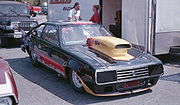
1979 AMC Spirit pro drag car
Building on the AMC Gremlin's ease with which they could be modified
for higher performance, as well as their inherent inexpensiveness and
strength, AMC Spirits were used in
drag racing.
According to Hot Rod magazine, "these little cars are very cool,
and while they're not traditional muscle cars, they're plenty strong in
terms of performance."[8]
Using mostly AMC hardware, the AMC Spirit can perform exceptionally well
as a street car and in multiple racing arenas (including quarter-mile
e.t. of 12.8 at 110 mph), with the finished vehicle costing only about
$10,000.[4]
Some Spirits have been fitted with 360 cu in (5.9 L)
AMC V8 engines and
run the quarter-mile drag strip on an 11.88 dial.[9]
AMC Spirits in the Factory Street class have run e.t. of 10.62 at 126.27
mph.[10]
AMC Spirits have also been heavily modified for pro class racing.
[edit]
Experimental Spirits
The AMC Spirit served as a test vehicle for alternative engine and
fuel experiments. These included the Mod 1
Stirling engine
powered AMC Spirit engineering test vehicle built by Mechanical
Technology Inc. to develop and demonstrate practical alternatives.[11]
[edit]
VAM models

1980 VAM "Gremlin" in Mexico
Mexican government-owned automaker
Vehiculos Automotores Mexicanos
(VAM) assembled sedan and liftback Spirits under license with AMC. To
meet government regulations, VAM vehicles had to have at least 50%
locally sourced parts. Mexican built "AMC's" came with different
exterior and interior trim, as well as model names than their
counterparts in the United States and Canada. For example, Spirit 2-door
sedans were called "Rallys", which was the name used in Mexico for AMC
Gremlins in the rest of North America. The VAM Rally liftback models
came in AMX, GT, and SST versions.
A unique to Mexico was the vehicle called the
VAM Lerma, which
was based on the Concord's 4-door chassis with the Spirit's front and
rear liftback body parts and unique rear quarter panels. All VAM engines
were of AMC design, but built in at the Hidalgo engine assembly plant.
They featured modifications to deal with low
octane fuel and
high altitudes. These included different head designs and exhaust
porting. An indigenous VAM engine was the 282 cu in (4.6 L) version of
the
AMC Straight-6 engine
with an enlarged bore and wider wider dished pistons (3.909" bore,
3.894" stroke).
[edit]
Dodge Spirit
The Spirit model name was used by
Chrysler Corporation that took over AMC in 1987, for a four-door
sedan called the
Dodge Spirit from 1989 to 1995.
MC PACER

T he
AMC Pacer is a two-door
compact
automobile produced
in the
United States by
the
American Motors Corporation
between 1975 and 1980. Its initial design idea was started in 1971. The
car's unusual rounded shape with massive
glass area greatly
contrasted with the mostly boxy, slab-sided models of the
era. The Pacer's "jellybean"
body style is a readily recognized icon of the 1970s.
AMC's chief stylist
Richard A. Teague
began work on the Pacer in 1971, anticipating an increase in demand for
smaller vehicles through the decade.
Car and Driver
magazine noted that "AMC said it was the first car designed from the
inside out. Four passengers were positioned with reasonable clearances
and then the rest of the car was built around them as compactly as
possible."
Designed to appear
futuristic, the
shape was highly rounded with a huge glass area, and was very unusual
for its time.
Road & Track
magazine described it as "fresh, bold and functional-looking".
Development was under Product Group Vice President
Gerald C. Meyers,
whose goal was to develop a car that was truly unique: "...everything
that we do must distinguish itself as being importantly different than
what can be expected from the competition..."[3]
Unique for a comparatively small car, the Pacer was as wide as a
full-size American car
of the era. Contrary to myth, it was not widened six inches (152.4 mm)
to make room for the
rear-wheel drive
configuration. According to an AMC market study from the early 1970s,
front-wheel drive
was never considered,[citation
needed]
although the editor of Road & Track asserted that front-wheel
drive, as well as a transverse mid-engined configuration, were among
"various mechanical layouts...tossed around by the idea people at AMC",
adding that "it's unlikely they ever had much hope of being able to
produce anything other than their traditional front engine and rear
drive, using components already in production."[4]
A rear-engined layout was also explored. 1975 AMC advertising literature
proclaimed it as "the first wide small car".
The width was dictated partly by marketing strategy—U.S. drivers were
accustomed to large vehicles, and the Pacer's occupants had the
impression of being in a larger car—and partly by the fact that AMC's
assembly lines were already set up for full-size cars. Also unique at the time, the passenger door was four inches (101 mm)
longer than the driver's. This made passenger loading easier,
particularly from the rear seats; and they would also tend to use the
safer curb side in countries that
drive on the right.
Ford used this design element in the 1990s
Ford Windstar
minivan. Teague's low-drag design, which predated the
fuel crisis and the
flood of small foreign imports into the American market, was highly
innovative. Its
drag coefficient of
0.43 was remarkably low for that time. Teague even eliminated rain
gutters, smoothly blending the tops of the doors into the roof—an
aerodynamic detail which, although criticized at the time for allowing
rain onto the front seat, has become the norm in today's designs.
The Pacer was also among the first production cars in the U.S. to
feature
rack-and-pinion steering.
The body was designed with the aim that structural lines protected it
from hit damages, AMC engineers claimed that they succeeded in more than
50% of the car surface.
In the mid-1970s the U.S. government mandated major safety
improvements for the 1980 model year, to include 50-mile-per-hour
(80 km/h) front-end crash testing, 25-mile-per-hour (40 km/h) side crash
testing and 30-mile-per-hour (48 km/h)
rollover testing,
as well as installation of bumpers to resist 5-mile-per-hour (8 km/h)
impact at the front and 10-mile-per-hour (16 km/h) at the rear. The
Pacer was designed to these specifications, and also had
laminated safety glass
in the windshield.
1975 AMC Pacer base model
General Motors,
Ford, and
Chrysler persuaded
the government that it was not financially viable to modify existing
production cars to comply with the new regulations, and that instead
each company would be put to the enormous expense of producing new,
safety-compliant vehicles. Accordingly the government requirements were
reduced, which led to the deletion of several safety features from the
production Pacer—for example the
roll bar over the
passenger compartment, and the bump in the roof that accommodated it.
The Pacer's remaining safety features were not strongly advertised, and
seldom influenced a potential customer's purchasing decision. The car's
extra weight—due in part to the safety equipment and the abundance of
heavy glass—hurt fuel economy: production models tested by the
United States Environmental Protection Agency
(EPA) gave 16 miles per US gallon (15 L/100 km; 19 mpg-imp)
in the city, but 26 miles per US gallon (9.0 L/100 km; 31 mpg-imp)
or better on the highway (depending on driving habits and transmission),
thanks to aerodynamic efficiency.
Originally the car was designed for a
Wankel rotary engine.
In 1973, AMC signed a licensing agreement with
Curtiss-Wright to
build Wankels for cars and
Jeep-type vehicles.
(The agreement also permitted Curtiss-Wright to sell rotaries
elsewhere.)[5]
Later, AMC decided instead to purchase the engines from
General Motors
(GM), who were developing them for use in their own cars. However, GM
canceled development in 1974 for reasons that included durability
issues, the fuel crisis, tooling costs (for the engines and also for a
new product line designed around the rotary's ultra-compact dimensions)
and the upcoming (late 1970s) U.S. emissions legislation. It was also
thought that the high-revving Wankel would not suit Americans accustomed
to low revs and high torque.
General Motors's change of plans left the Pacer without an engine.
American Motors took a calculated risk and introduced the new model. [6]
The company's overcommitment to the project resulted in entrapment with
so much money and effort in the car's design.[6]
Engineers hastily reconfigured it to accept their existing
straight-six engine.
This involved a complete redesign of drivetrain and firewall to keep the
longer engine within the body dimensions designed for the Wankel, but
allowed the Pacer to share many mechanical components with other AMC
models.
The " outside
of the box" thinking incorporated by AMC
in the Pacer as the first "wide, small car" attempted to capture a
revolutionary change in marketplace.[7]
However, a radical departure from what was accepted by consumers as
"good styling" was a risky strategy.[8]
Only the largest firms can stick with a radical element until it
"grows", and the automaker’s dominance in the
marketplace may
eventually establish it as a standard feature.[8]
However, the styling research
axiom no longer
applied by the late 1970s that if a car with some controversial styling
was liked by at least half of the potential
market segment;
then chances were good that this feature was a differential advantage
for the manufacturer.[8]
The AMC Pacer incorporated many controversial styling and design
innovations led to its market failure after five model years.[8]
American Motors created the Pacer by identifying emerging trends and
design technologies, but it faced a small window of opportunity since a
product that comes out either too early or too late can fail even if the
opportunity was there initially.[9]
A further complication was the purchasing dynamics and the Pacer's
design was focused on maximizing the internal sense of space, while the
market focused on external dimensions. Many of the attributes the Pacer
incorporated became the goal of all manufacturers in the two decades
that followed.[9]
With an uncommonly wide and short body for a small car, the Pacer’s
design is still considered controversial while its powerplants did not
contribute to fuel economy. Nevertheless, “the foresight by Teague and
AMC was correct” with approaches to meet the evolving U.S. government
regulations covering automobiles (such as the Highway Safety Act of 1970
and the new
National Highway Traffic Safety Administration).[10]
[edit]
Production
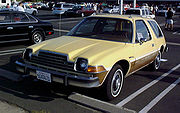
1978 AMC Pacer station wagon.
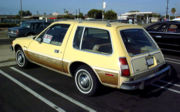
Wagon looks more conventional than
hatchback
Introduced in showrooms on
February 28,
1975, the
Pacer was designed to attract buyers of traditional large cars to a
smaller package during a time when gasoline prices were projected to
rise dramatically.[11]
In its first year of production, the Pacer sold well, with 145,528
units. Some reviewers referred to it as a "fishbowl on wheels" or a
"jellybean in suspenders" because of its unconventional styling, while
some described it as a "cute" car. There was little competition from
other American manufacturers, most of whom had been blindsided by the
oil crisis. The
increased demand for compact, economy vehicles was growing rapidly.
However, Pacer sales fell after the first two years, and it was
available through the 1980 model year. Similar to its mid-year
introduction, on
December 3,
1979,
production of the Pacer ended at the
Kenosha, Wisconsin
assembly plant where it had begun five years earlier.[12]
A total of 280,000 cars were built. Increasing competition from the Big
Three U.S. automakers and the rapid consumer shift to imported cars
during the late 1970s are cited as the reasons for this outcome.
The Pacer's unconventional styling was commonly cited in its lack of
success. Other concerns included a lack of cargo space when carrying a
full load of passengers (because of its short
wheelbase). Cargo
space could be increased to 29.5 cubic feet (0.84 m3) by
folding down the back of the rear seat to form a flat floor. Drivers
also cited a lack of power. The Pacer was heavy; Car & Driver
wrote, "American Motors had already quoted a curb weight of 2990 lb. for
the basic Pacer when we first wrote about the car, and that already
seemed quite heavy; but when we weighed the test car (whose air
conditioning,
automatic transmission,
power steering and so forth would not account for the full difference)
it registered an astounding 3425 lb."[13],
and the standard 232 cu in (3.8 L)
I6, with a
single-barrel
carburetor and
optimized for
low emissions (all
vehicles at the time carried emissions-reducing devices); was relatively
low-powered ("The Pacer comes with either of two AMC inline six-cylinder
engines, both producing 100 bhp, but the larger 258-cu-in. unit
delivering better mid-range torque"[13]).
In 1976, a "High Output" version of the 258 cu in (4.2 L) engine was
offered, which helped performance at the cost of higher fuel
consumption. By the time a 304 cu in (5 L)
V8 was offered in
1978, the company had introduced a successful line of "luxury-compact"
models (the
AMC Concord).
Additionally, gasoline prices remained high, limiting demand for
V8-powered vehicles.
For increased cargo capacity, a
station wagon body
style was offered from 1977. The wagon version was only five inches
longer (127 mm) and weighed only 76 pounds (34 kg) more than the coupe.
It was also a less unusual-looking design with a squared-off back and
straight, almost upright, rear side windows. Although front vent windows
were optional on all Pacers, the wagon's rear side glass featured vent
windows as standard. The broad and rear
liftgate opened to
a wide, flat cargo area with 47.8 cubic feet (1.35 m3) of
space, significantly easing the task of loading cargo. The rear seat
also folded flat to form a continuation of the cargo floor. Some wagon
models featured simulated wood-grain trim on the lower body sides and
the liftgate.
[edit]
Model designations
During the Pacer's production and marketing, the car went from
initially being promoted as an economy car, to becoming a small luxury
car. The following information details some of the highlights. The
"X" Package: A "sporty" edition Pacer. The Pacer X was available
from 1975-1978 on the coupe version of the car. The title changed to
"Sport" in 1978 and was eliminated after that. The
trim package
consisted of vinyl bucket seats, sports steering wheel, custom trim, as
well as a floor mounted gear shift and front
sway bar. On the
outside it received exterior chrome features, styled road wheels, and
"Pacer X" decals on the doors and other package identification.
The "D/L" Package: A more upscale edition of Pacer, the D/L
was available for the entire run of the car becoming the "base" model in
1978. This package was more "luxurious" including, originally, a
"Navajo-design" seating fabric and a woodgrain instrument panel as well
as a few interior features that were optional without it. The exterior
received additional chrome accents, different wheelcovers, and
identification badging.
The "Limited": Available in 1979-1980, the Limited model was
an elegant farewell for Pacer. Inside, leather seating, extra sound
proofing, and deeper-pile carpet (18-oz. vs. the standard 12-oz) was
standard, as were many amenities that would have been options: AM radio,
power door locks,
power windows, and
tilt
steering wheel, to
name a few. The exterior offered many chrome accents, styled road
wheels, and exterior "Limited" identification badging.
The "Sundowner": In 1975 only, a Sundowner Pacer was available
through AMC dealers in California. This marketing promotion consited of
the basic Pacer with a $3,599
suggested retail price.
This package included options listing for $300 at no extra cost.[14]
In addition to the mandatory California engine emissions controls and
state-required bumper guards, the Sundowner package included a "custom
interior" featuring Basketry Weave fabric upholstery with coordinated
trim on the door panels, remote control exterior mirror, rear window
washer and wiper, styled road wheels with white wall tires, and a roof
rack.[15]
The "Levi's" Package :
Attempting to capitalize on the popularity of the Levi's Gremlin and
Hornet, AMC introduced a Levi's Pacer for 1977. This option added blue
denim-like upholstery and door panel trim, with small "Levi's" tags on
both front seats. Missing were the traditional copper buttons found on
the other AMC Levi's seating. The package also included a "Levi's" logo
sticker for each front fender. It could be combined with the Pacer "X"
package. Not well promoted, the Levi's Pacer did not sell in large
numbers and was gone for the 1978 model year.
Carl Green Enterprises (CGE) Pacers: Numerous Pacers were
modified by Carl Green, automobile designer. These cars included
401 cu in (6.6 L)
AMC V8 engines, as
well as flares, air dams, and wings.[16]
The custom cars cars appeared in magazines such as
Hot Rod,Popular
Hot Rodding, and
Car & Driver. Carl
Green also built two AMC Pacer
pace cars for B.F.
Goodrich to campaign in the
International Motor Sports Association
circuit, as well as provided body kits for Amos Johnson's Team Highball
racecars.[17]
All Pacers without the optional vinyl roof trim could be finished in
several unique two-tone paint combinations [18]
that included front and rear body side scuff molding extensions.
However, the top and bottom two-tone treatment was changed in 1977, to
an "up and over the roof" accent paint scheme for the duration of
production.[19]
1979-1980 saw a hood ornament and center chrome strip down the hood.
Power door locks
were available in 1978; however it would be 1979 beforepower
windows would join the option list.
[edit]
International markets
[edit]
Europe
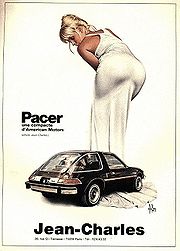
French magazine advertisement from
1975.
American Motors exported the Pacer to several
European nations.
The AMC distributor in
Paris France,
Jean-Charles, compared the rounded body of the new Pacer to another
attractive rear-end shape in its magazine advertisements. Cars exported
to Europe were available in higher trim levels.[20]
According to some reports, the Pacer sold well in Europe and even
Brigitte Bardot is
said to have promoted the car in Paris.[21]
The level of current European interest in Pacers is indicated by the
number of European nations listed in the AMC Pacer Registry, [22]
the members' cars in the Swedish AMC/Rambler Society,[23]
a
German Pacer
enthusiast Internet site,[24]
and the fact that a former AMC dealer in Germany[25]
stocked an inventory of original parts as recently as the early 2000s. A
private museum in the
Netherlands
exhibits a Pacer wagon.[26]
[edit]
United Kingdom
Unlike AMC's other models, [citation
needed]
the Pacer was only available with
left-hand drive.
The British importer for the Pacer converted the car from left-hand to
right-hand drive by leaving the majority of the steering gear on the
left-hand side of the car, and running a
chain-drive behind
the dashboard from the steering wheel (now on the right-hand side) to
the top of the
steering column.
However, the car retained its unequal-length doors, designed for LHD
markets, meaning that in the UK the longer door was on the driver's
side, leaving the passengers to use the smaller door, which "in the
typically confined British parking spot was virtually impossible."[27].
The Pacer was wider than a
Rolls-Royce Silver Shadow
and slightly longer than the then-current
Ford Cortina.
[27].
The car was adversely reviewed by the motoring press and AMC soon
stopped importing it. [27]
[edit]
Mexico
The Pacer was produced in
Mexico by
Vehículos Automotores Mexicanos
(VAM) starting in 1976. The cars came with different engines, interiors,
and other components because vehicles made in Mexico had to have at
least 50% locally sourced parts. The engine was an AMC design, but
modified and built by VAM. A unique to Mexico 282 cu in (4.62 L)
I6 engine was
standard. It was designed to cope with low
octane fuel and
high altitudes. This engine featured dished pistons with a 3.909-inch
(99.3 mm) bore and 3.894-inch (98.9 mm) stroke, as well as a unique head
and exhaust porting design. The V8 engine was not available in Mexico.
All Pacers built by VAM came with the following standard equipment:
power disk brakes, power steering, handling package, slot wheels with
ER78x14 radial tires, reclining front seats, and a radio. [28]
Only the coupe model was available. The Mexican Pacers also had
different interior trim and seats that featured high-design upholstery
that was not available in the U.S. models.[29]
For 1979, a total of 250 luxury and performance "Limited edition X"
models were built using a modified 282 six-cylinder with an automatic
transmission, air conditioning, sunroof, as well as other options.
[edit]
Opinions
[edit]
Magazines and newspapers
In 1975, the AMC Pacer was sleek and audacious; unlike anything else
on the road and it looked like the car of the future. [30]
"The automotive press loved it."[30]
The February 1975 issue of
Motor Trend
magazine called "it the most revolutionary American car in 15 years" and
wrote, "Suddenly, it's 1980" recalling the famous
Forward Look
slogan.[31]
Reviewers were positive about the Pacer's styling, and Small Cars
magazine described the press preview that "admiration was an obvious
reaction...the knowledgeable product writers knew without being told
that they were privileged to be there to see something new in automobile
design." [30]
Michael Lamm, writing in
Popular Mechanics,
said that with its "very modern styling, ample power and generous
interior" he felt it was "more car" than "the
Mustang II or "GM’s
sporty compacts (Monza,
Skyhawk/Starfire)", and that its performance felt "strong—certainly on a
par with most V8s."[32]
Automotive journalist and author Don Sherman wrote in the February
1975 issue of
Car and Driver that
it was "our first real urban transporter...There is, of course, the
chance of monumental failure; it might be another Tucker ahead of its
time or a pariah like the Marlin. But...with its high priority on
comfortable and efficient travel and absence of Mach 2 styling, [it] at
least seems right for the current state of duress. Consider this bold
offering from AMC a test: Are we buying cars for transportation yet, or
are they still social props?"[1]
Road & Track
magazine's April 1975 road test review described the Pacer's appearance
as "bold, clean and unique...even when it's going 60 mph is looks as if
it's standing still..." but noted that, even with the test car's
optional front disc brakes, "in the usual panic-stop tests...our driver
had one of his most anxious moments ever as the Pacer screeched, skidded
and demanded expert attention at the steering wheel to keep from going
altogether out of control. The histrionics are reflected in long
stopping distances from highway speeds... [The car’s]
engineering—old-fashioned and unimaginative in the extreme—does not
match the perky design", which the magazine declared "most attractive to
look at and pleasant to sit in."[33]
In a follow up road test in August 1976, Motor Trend wrote: "Since
its introduction in January of 1975, we have been quite smitten with
AMC’s Pacer." [34]
Their only major gripes were the lackadaisical performance and the
absence of a 4-speed transmission. A 2-barrel carburetor was offered on
the larger six at the end of 1975, as well as a 4-speed manual, but the
testers noted "the 2-bbl Pacer was faster than the 1-bbl car by a fair
margin, it did not feel faster" (author's emphasis).[34]
Motor Trend described that: "Even with its compact exterior dimensions,
the Pacer is one of the most comfortable 4-passenger cars around...The
wide bucket seats were firm, but very comfortable...Front passenger leg
room is extraordinary even with the seat racked well forward, and the
rear seat leg room exceeds such full-sizers as the
Buick Riviera and
Continental Mark IV."[34]
The Pacer received a
facelift and an
optional V8 engine in 1978, but retained the heavy-duty crash protection
making its body bulkier and heavier than it would otherwise have been.
By this point, the luster wore off the unique design and the press began
badmouthing the Pacer's lack of power and performance as more
sophisticated competitors were introduced.
[The Pacer features in several lists solicited from the general public
and published online, e.g.:
-
MSNBC.com's
2005 "least-loved American autos".[46]
-
Time.com's 2007
"50 Worst Cars of All Time".[47]
- "The Most Questionable Car Designs of All Time", a 2007
non-scientific survey of policyholders with a major collector-car
insurance company.
Now old enough to be a
"classic car", the
Pacer has come to be regarded in some quarters as a 1970s design icon.[50]
(According to
Business Week
magazine the 1970s were "infamous for
disco,
Watergate and some
of the ugliest cars ever." Nevertheless, in spite of their bad reputations, cars of the 1970s
era such as the Pacer are becoming collectors' items.
Business Week reported that the rising values of so-called "nerd
cars"
- ugly 1970s-era cars
- prompted the CEO of a major collector-car insurance company
to buy a Pacer,
which has "inexplicably appreciated substantially beyond the $2,300 that
he paid for it in 2004."[53]
In 2002 he said: "In what can sometimes be a sea of automotive sameness,
the AMC Pacer continues to turn heads even today",[55]
and he put the value of a "mint Pacer" at "between $4000 and $6000",
saying that "the increased value is fueled solely by the heart. This
trend is all about a fascination with '70s things almost because
they were so bad." (Author's emphasis.)
The Pacer has been described as one of the formerly unloved cars from
the 1970s that are enjoying a resurgence in both collectibility and auto
restoration — especially among fans of cars from that era. The Pacer is one of several 1970s cars that were always thought of as
cheap vehicles; therefore they were poorly maintained, which reduced
their life expectancy.
Also the heavy engines used in the car put more load on the front
suspension than intended, which caused the rack & pinion steering to
fail frequently on Pacers built in 1975. One longtime collector-car expert says you will pay just about the
same, around $20,000, for a complete restoration, whether it’s on a
$1,000 1978 AMC Pacer or a $5,000 1969 Chevrolet Camaro. When restored,
the value of the Pacer may be about $4,000, compared with the Camaro’s
$25,000. Today the Pacer's originality, as well as its deficiencies, are
appreciated, if not loved, by car hobbyists and serious collectors
alike.
Here's a
heartwarming web site about one Pacer in particular.
There are many active AMC car clubs that welcome Pacers. [60]
Pacers share the drivetrain as well as other parts and components with
AMC models, while
new old stock
(NOS), used, and reproduction parts are available from vendors
specializing in AMC vehicles.
|
